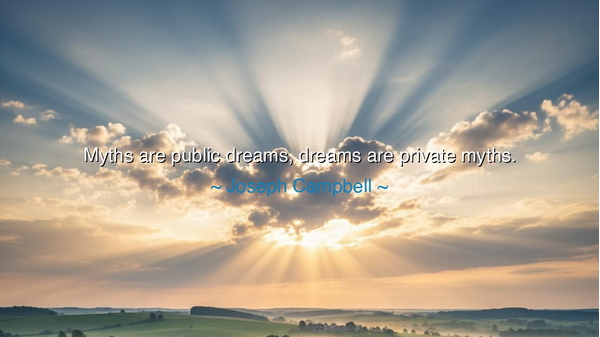
Myths are public dreams, dreams are private myths.






“Myths are public dreams, dreams are private myths.” — so spoke Joseph Campbell, the great weaver of stories and the interpreter of the human soul. In these words, he reveals the sacred mirror between the inner world of the dreamer and the outer world of mankind’s legends. He tells us that what we dream in solitude, humanity dreams together as myth — and what humanity once imagined in myth, we continue to dream in secret within ourselves. For both myth and dream are woven of the same fabric: the fabric of symbols, desire, and the deep imagination of the spirit.
The origin of this saying lies within Campbell’s lifelong study of mythology, psychology, and spirituality — his effort to uncover what he called the monomyth, or “the hero’s journey,” which he described in his landmark work The Hero with a Thousand Faces. He saw that all the world’s myths — from the Greek tales of Zeus and Athena, to the Hindu epics of Rama and Krishna, to the stories of Christ and the Buddha — are not mere fictions. They are reflections of the human psyche, collective expressions of our dreams, fears, and hopes. Just as the individual, in dreams, journeys through images and trials to uncover hidden truths about the self, so too do societies dream through myth to understand the mysteries of existence, destiny, and the divine.
To Campbell, the dream is the private version of the same process — a sacred story unfolding within the walls of the mind. When we dream, we enter our own mythic landscape: we become the hero, the wanderer, the lover, the warrior. Our subconscious speaks to us in symbols — the mountain we must climb, the monster we must face, the lost treasure we must reclaim. These are not meaningless illusions, but messages from the depths of the soul, where the mythic pattern of humanity lives in miniature. Thus, the dreamer and the myth-maker are kin; one speaks for himself, the other for the world, but both speak in the language of the eternal imagination.
Consider the ancient tale of Gilgamesh, one of the oldest myths known to man. The king, haunted by the death of his friend, sets out on a perilous journey to seek immortality. His quest leads him to the edge of the world, where he learns that eternity lies not in endless life, but in wisdom and love. This myth is the public dream of an ancient people wrestling with mortality, meaning, and loss. Yet even now, the same story lives within us — when we grieve, when we seek purpose, when we face the boundaries of our own mortality. When we dream of death and rebirth, of falling and rising again, we dream as Gilgamesh dreamed. Our private dream becomes part of the ancient mythic rhythm of humankind.
Campbell’s insight reveals that myths and dreams are not separate from life, but threads of the same great tapestry. In myths, we find the eternal patterns of the human experience; in dreams, we feel them personally. Myths tell us what it means to live, to love, to die, and to transcend — and our dreams remind us that these same forces move within our own souls. The hero who slays the dragon, the mother who births a savior, the wanderer who finds his home again — these are not just old stories, but archetypes of our inner journeys. The mythic and the personal are but reflections of each other, as the ocean reflects the moon.
Yet there is also a challenge in Campbell’s words. For in the modern world, we have forgotten how to dream — not the dreams of sleep, but the mythic imagination that once gave meaning to existence. We have filled our days with noise and our nights with distraction, and so the voice of the ancient within us grows faint. Campbell calls us to remember: to dream deeply, to listen to the symbols of the soul, and to rediscover our connection to the great myths that once guided humanity. For when we lose myth, we lose meaning; when we silence the dream, we silence the language of the heart.
So, my listener, take this wisdom as a call to awaken the dreamer within. Pay attention to your dreams, for they are your private mythology — your soul speaking in story. Read the myths of old, for they are your public dreams — humanity’s sacred reflection of the same mystery. See in the tales of gods and heroes the image of your own struggle for truth, courage, and love. And when you act in your own life, act as the hero acts — with awareness, with compassion, with faith in the journey.
For in the end, Joseph Campbell’s words remind us that the dreamer and the hero are one. The myths we inherit are the maps of our inner world, and the dreams we live are the myths of our own making. To live with meaning is to walk consciously within both — to dream, and to turn that dream into life. For life itself, if lived deeply and bravely, becomes the greatest myth of all — the story of the soul awakening to its own divinity.






AAdministratorAdministrator
Welcome, honored guests. Please leave a comment, we will respond soon